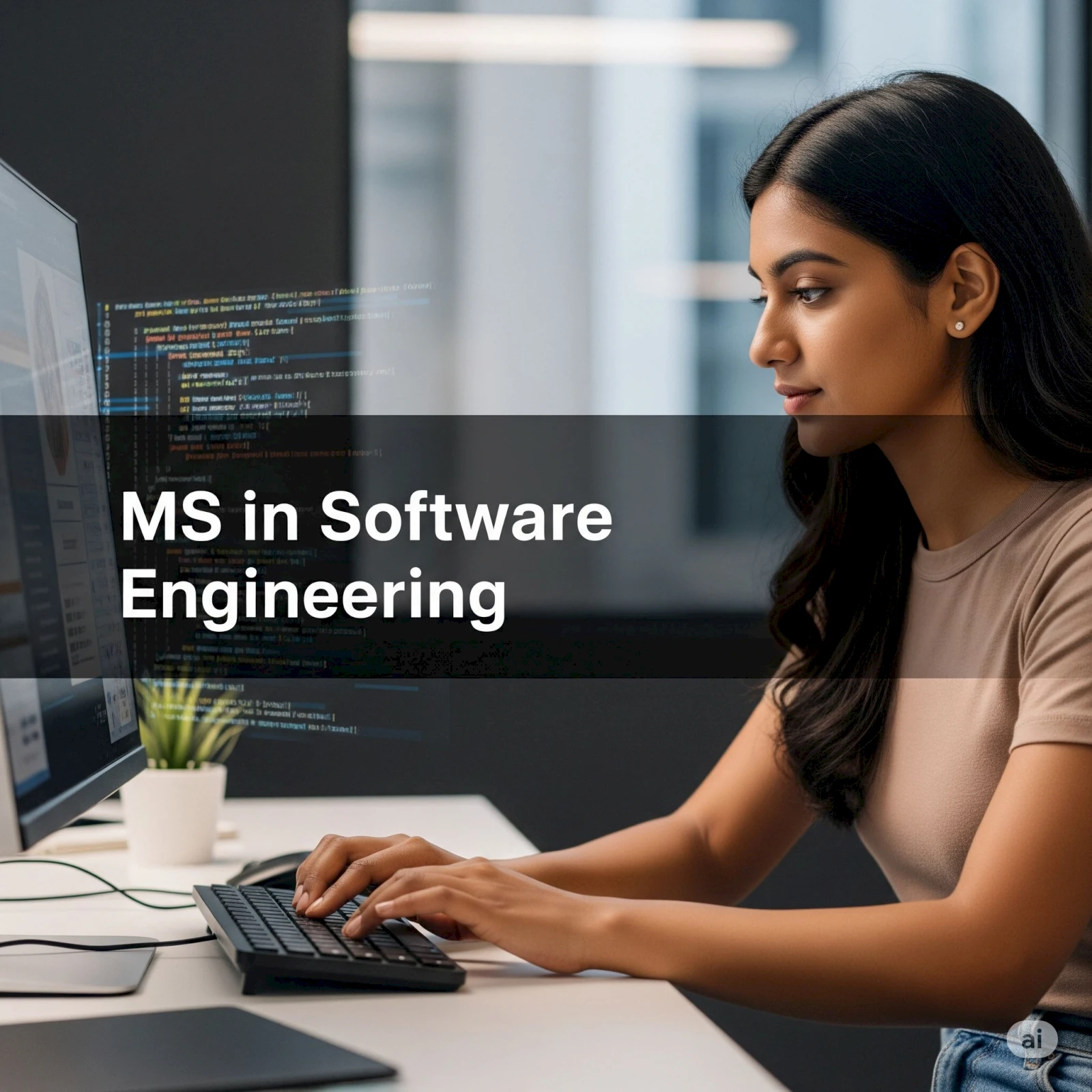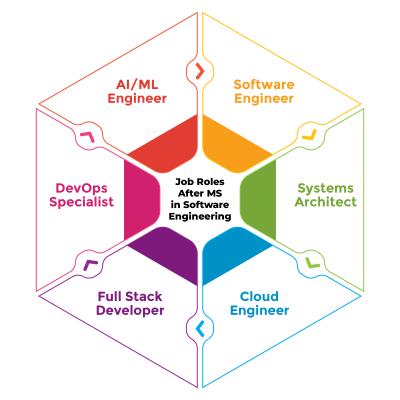From Classroom to Codebase: Charting Your Global Path with an MS in Software Engineering

Blog / June 28, 2025
MS in Software EngineeringMS Software Engineering Course ContentAdvantages of an MS in Software EngineeringEvery decade has its career catalyst. In the 1980s, it was hardware. In the 2000s, it was IT services. Today, the clear frontrunner is software engineering.
This isn’t a trend; it’s a transformation. Software engineering now powers everything from intelligent healthcare systems and space exploration to fintech and immersive learning platforms. At the core of this shift is a deeper truth: today’s software engineers are more than coders; they’re problem solvers, systems thinkers, and digital architects.
From autonomous platforms to cloud-native applications and secure digital infrastructure, today’s industries run on software designed for resilience, scale, and speed. The professionals building these systems aren’t just developers. They’re software engineers trained to lead architecture decisions, manage full-stack lifecycles, and optimize real-world performance.
That’s where the MS in Software Engineering comes in.
For ambitious learners, this degree is no longer just an academic pursuit. It’s a practical, strategic step to build resilience in a career shaped by constant reinvention. Unlike general computing degrees, this master’s is purpose-built for those who want to work on real-time systems, complex deployments, AI-enabled services, and multi-cloud infrastructures. It brings depth to areas like DevOps automation, secure API design, systems integration, and scalable microservices.

The Confusion Between Software Engineering and Computer Science
Many prospective students often mix up two fields that seem alike: Software Engineering and Computer Science.
The distinction matters.
- Computer Science dives into theoretical principles: algorithms, computer architecture, compilers, programming languages, operating systems, databases, machine learning, discrete mathematics, etc.
- Software Engineering is centered on the disciplined design and development of large-scale systems that solve real business and societal problems. It emphasizes not only the technical foundations of computing but also the collaborative methods, engineering practices, and organizational tools needed to build complex systems in team environments.
Where Computer Science often explores what’s possible in theory, Software Engineering is about what works in practice: what’s scalable, maintainable, and ready for deployment. It covers essential engineering workflows: version control, agile methodologies, test automation, architectural design, DevOps pipelines, and more.
If one is thinking of building and leading actual software products in industry, Software Engineering provides a stronger toolkit.
How an MS in Software Engineering Turns Knowledge into Execution
The leap from academic theory to industry-ready skill can be steep. A Master’s in Software Engineering bridges that gap with:
- Project-based learning grounded in real-world use cases
- Exposure to team collaboration, agile workflows, and product lifecycle management
- Hands-on modules in cloud systems, AI-enabled software, and modern application frameworks
Unlike traditional undergraduate programs, which often stop at syntax or data structures, a master's program equips students to:
- Design and deploy scalable software
- Work across the stack (frontend, backend, cloud integration)
- Use engineering discipline to manage complexity
A master’s makes students more than contributors; it turns them into architects and future tech leads.
Looking Through the Numbers: Why MS in Software Engineering Is a Smart Career Investment
In a tech economy defined by scale, speed, and skill shortages, the data points to one clear conclusion: a Master’s in Software Engineering is a rocket behind career launch.
Here’s what the numbers say:
According to a report published in Reuters:
- Nasscom expects India's technology sector's revenue will grow 5.1% to $282.6 billion in fiscal 2025, compared with the previous fiscal's 4%, with revenue crossing $300 billion in fiscal 2026.
- Software exports, comprising services and sales of products to clients, are expected to grow 4.6% to $224.4 billion in fiscal year 2025, the industry body said.
- The sector is expected to add 126,000 jobs on a net basis, taking the total workforce to 5.8 million in fiscal year 2025.
Nasscom’s president Rajesh Nambiar told the Times of India in an interaction:
- India's technology industry is poised to expand to $350 billion by 2030, up from $254 billion in 2023–24. The sector's expansion reflects a CAGR of 6.4%
Not only this, but also:
- The U.S. alone forecasts 327,000 new software roles by 2033.
- The World Economic Forum predicts 170 million new jobs globally by 2030, led by software, data, and AI domains.
Talent Gaps Create Urgency
- By 2030, the global economy may face a shortage of 85 million tech workers, risking $8.5 trillion in lost revenue. [Korn Ferry]
- Europe’s talent gap could hit 3.9 million unfilled tech roles by 2027. [McKinsey]
MS = Higher Hiring and Better Roles
- 93% of AI and data scientists hold a Master’s or Ph.D.; 45% of job listings demand it. [Rice University]
The Earnings Premium Is Real
- In the U.S., MS grads in computer science earn $82,275 vs. $68,103 for Bachelor’s holders, a 20% higher pay. [NACE]
The data paints a compelling picture: pursuing a Master’s in Software Engineering is a timely and strategic move for those looking to thrive in the fast-growing tech landscape.
Future-Proofing Your Tech Career with an MS in Software Engineering
The MS in Software Engineering program future-proofs careers by focusing on:
Key Transferable Skills:
- Full-stack development exposure
- Cross-functional collaboration
- Agile and DevOps methodologies
Future-Tech Adaptability:
- Fast onboarding with new languages and tools
- Applying design thinking to evolving problems
- Understanding ethics in AI, data, and automation
With upskilling at the center of the learning model, this program ensures engineers don’t just adapt; they anticipate change.
The MS in Software Engineering program prepares students for roles that go beyond coding. Let’s break them down.
Core Roles for Graduates:
- Software Engineer
- Systems Architect
- Cloud Engineer
- Full Stack Developer
- DevOps Specialist and
- QA/Test Automation Lead
Specialized & Emerging Roles:
- AI/ML Engineer
- Cybersecurity Analyst
- Blockchain Developer
- Site Reliability Engineer (SRE) and
- Product Engineer (Tech-First Roles)
The Long-Term Payoff of an MS in Software Engineering Program
A graduate degree in software engineering isn’t just about a higher salary; it’s about opening the door to compound career growth.
The long-term benefits:
- Faster promotions to mid/senior roles
- Access to global job markets
- Entry into technical leadership paths
- Higher project ownership, from prototyping to deployment
Graduates also often pivot into adjacent high-value careers, including:
- Technical product management
- Tech entrepreneurship
- Research and innovation labs
A Smarter Path to a U.S. Degree: The Shiv Nadar University + Arizona State University Joint MS in Software Engineering Program
Most students aiming for an MS in Software Engineering worry about three things: cost, admissions process, and value for effort.
What if there were a smarter, safer way to a U.S. degree?
That’s what the Shiv Nadar University + Arizona State University (ASU) pathway offers. It’s not a shortcut. It’s a strategic route. This MS in Software Engineering program blends the credibility of ASU with a practical start at Shiv Nadar University International College (SNU IC).
Here’s how it works:
- 1 Semester at Shiv Nadar University International College
- Transfer credits to ASU for admission into a Master's program
- ASU MASTER'S DEGREE in 1 year /1.5 years
- OPT up to 3 years in the U.S.
What does this mean?
- One pays far less for the full degree
- There’s no compromise on coursework, faculty, or access
- One gets a smoother transition: academically, financially, and culturally
The first semester helps one adjust to the MS pace without jumping straight into the U.S. education system. It also reduces overall tuition and living costs by a huge margin compared to studying entirely in the U.S.
And the outcome?
One still lands in the U.S. with full STEM OPT eligibility, ASU’s global reputation, and the same job market exposure. This program isn’t just about affordability. It’s about giving Indian students a confident entry point into software engineering masters programs at a top-tier U.S. university.
Who Should Consider This Program?
This program fits well for students who:
- Want international exposure without paying the full U.S. cost upfront
- Seek hands-on, applied learning instead of just theory
- Prefer career outcomes tied to industry needs—like DevOps, AI, product design, or cloud systems
- Plan to work in the U.S. post-study and need a degree that qualifies for 3-year OPT
- who value mentorship and structured academic transition
This model removes the anxiety many face when jumping straight from India to the U.S. Instead of rushing into a foreign system, one gets a strong head start in a known learning environment.
It also makes the ASU MS in Software Engineering accessible to many who might otherwise skip applying.
Affordability Without Compromise
One doesn’t have to empty their savings to earn a top-tier U.S. degree. The SNU + ASU model proves that.
Let’s look at the numbers.
- Estimated program Fees at Shiv Nadar University (in INR): 3,00,000
- Estimated Program Fee for Accelerated Master’s program at ASU (in USD): 35,946
- Approximate cost of housing, etc. (in USD): 20,000 per year
|
Cost Component |
SNU + ASU Pathway |
Full U.S. MS Route |
|
Tuition in India (1 semester) |
3 lakhs rupees |
₹0 |
|
Tuition in the U.S. |
$35,946 |
$70,000–$75,000 |
|
Total Living Expenses (US only) |
$20,000 |
$40,000 |
|
Total Cost (Approx) |
50-52 lakhs |
95 lakhs to 1 crore rupees |
That’s a difference of at least ₹40 lakhs. And no quality is sacrificed. Students still earn a globally recognized MS in Software Engineering from Arizona State University. This makes the ASU MS in Software Engineering accessible to many who might otherwise skip applying because of the cost barrier.
What about financial support?
- Loans up to 100%, including tuition + living expenses, available with no co-signer
- No collateral required, offered through verified education loan partners
Admission Requirements
GPA Requirements (Bachelor’s)
- Min. GPA 3.00 in last 60 credit hours of bachelor’s
- Or GPA 3.00 in the last 12 credit hours of any post-bachelor coursework
English Proficiency Requirements
- TOEFL: >90 (iBT)
- IELTS: >7.0
- Pearson: >64
- Duolingo: >125
Other Documents Required
- Graduate admissions application + fee
- Official transcripts
- Short answer questions
- One Letter of recommendation
- Professional resume
- Written statement
- Proof of English proficiency
For students focused on building a serious career in software engineering, the Shiv Nadar University + Arizona State University MS in Software Engineering program provides a clear academic path, strong industry alignment, and global career readiness, starting from day one.
Conclusion
An MS in Software Engineering builds the foundation for roles that demand both technical depth and applied thinking. From scalable architecture to DevOps pipelines, the program prepares one to work on real systems in real environments. The Shiv Nadar University and Arizona State University pathway offers the same U.S. degree with a more efficient, cost-effective start. It blends global exposure with industry-relevant training, making it a strong choice among software engineering masters programs. For students planning a future in software engineering with long-term career mobility, the MS in Software Engineering Arizona State University + Shiv Nadar University model offers clarity, structure, and professional reach, right from the first semester.
FAQs
What is the duration of the MS in Software Engineering program?
It runs for about 18-24 months. One semester is completed at SNU IC, followed by 12-18 months at ASU in the U.S.
Do I need a GRE score to apply?
No. This specific pathway doesn’t require a GRE, making it easier to apply without compromising program quality.
What degree will I receive after graduation?
The final degree is awarded by Arizona State University. It holds the same recognition as any U.S.-only MS program.